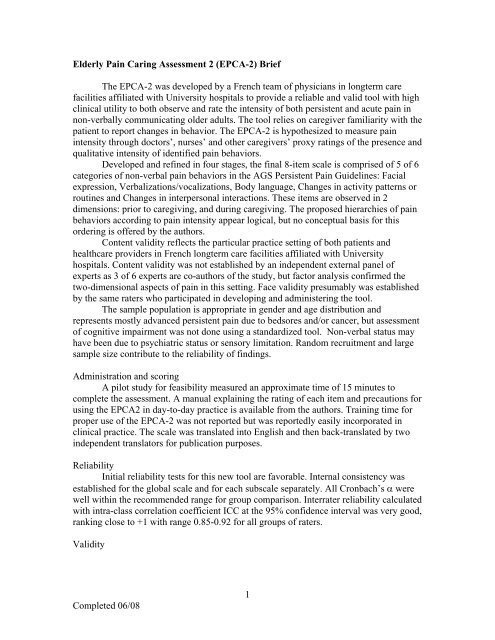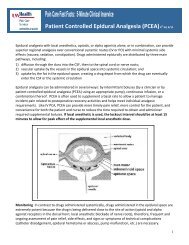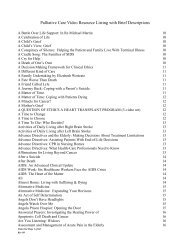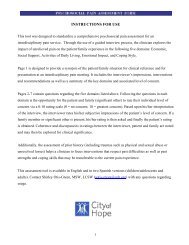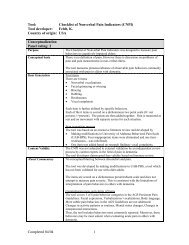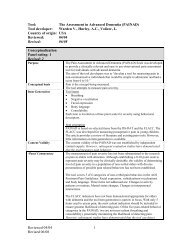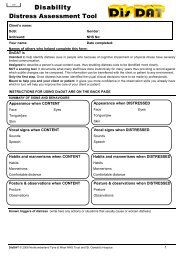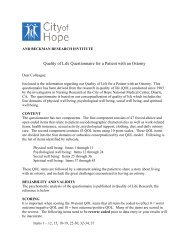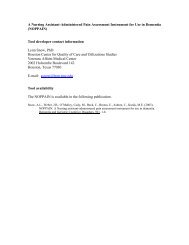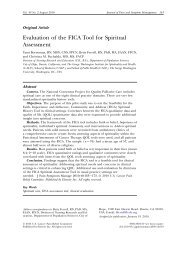1 Completed 06/08 Elderly Pain Caring Assessment 2 (EPCA-2 ...
1 Completed 06/08 Elderly Pain Caring Assessment 2 (EPCA-2 ...
1 Completed 06/08 Elderly Pain Caring Assessment 2 (EPCA-2 ...
You also want an ePaper? Increase the reach of your titles
YUMPU automatically turns print PDFs into web optimized ePapers that Google loves.
<strong>Elderly</strong> <strong>Pain</strong> <strong>Caring</strong> <strong>Assessment</strong> 2 (<strong>EPCA</strong>-2) BriefThe <strong>EPCA</strong>-2 was developed by a French team of physicians in longterm carefacilities affiliated with University hospitals to provide a reliable and valid tool with highclinical utility to both observe and rate the intensity of both persistent and acute pain innon-verbally communicating older adults. The tool relies on caregiver familiarity with thepatient to report changes in behavior. The <strong>EPCA</strong>-2 is hypothesized to measure painintensity through doctors’, nurses’ and other caregivers’ proxy ratings of the presence andqualitative intensity of identified pain behaviors.Developed and refined in four stages, the final 8-item scale is comprised of 5 of 6categories of non-verbal pain behaviors in the AGS Persistent <strong>Pain</strong> Guidelines: Facialexpression, Verbalizations/vocalizations, Body language, Changes in activity patterns orroutines and Changes in interpersonal interactions. These items are observed in 2dimensions: prior to caregiving, and during caregiving. The proposed hierarchies of painbehaviors according to pain intensity appear logical, but no conceptual basis for thisordering is offered by the authors.Content validity reflects the particular practice setting of both patients andhealthcare providers in French longterm care facilities affiliated with Universityhospitals. Content validity was not established by an independent external panel ofexperts as 3 of 6 experts are co-authors of the study, but factor analysis confirmed thetwo-dimensional aspects of pain in this setting. Face validity presumably was establishedby the same raters who participated in developing and administering the tool.The sample population is appropriate in gender and age distribution andrepresents mostly advanced persistent pain due to bedsores and/or cancer, but assessmentof cognitive impairment was not done using a standardized tool. Non-verbal status mayhave been due to psychiatric status or sensory limitation. Random recruitment and largesample size contribute to the reliability of findings.Administration and scoringA pilot study for feasibility measured an approximate time of 15 minutes tocomplete the assessment. A manual explaining the rating of each item and precautions forusing the <strong>EPCA</strong>2 in day-to-day practice is available from the authors. Training time forproper use of the <strong>EPCA</strong>-2 was not reported but was reportedly easily incorporated inclinical practice. The scale was translated into English and then back-translated by twoindependent translators for publication purposes.ReliabilityInitial reliability tests for this new tool are favorable. Internal consistency wasestablished for the global scale and for each subscale separately. All Cronbach’s α werewell within the recommended range for group comparison. Interrater reliability calculatedwith intra-class correlation coefficient ICC at the 95% confidence interval was very good,ranking close to +1 with range 0.85-0.92 for all groups of raters.Validity<strong>Completed</strong> <strong>06</strong>/<strong>08</strong>1
Tool developers bring strong evidence for good convergent and discriminantvalidity and responsiveness of the <strong>EPCA</strong>-2. Factor analysis confirmed the 2 factors ofrest and caregiving pain and explained 56% of the variation in <strong>EPCA</strong> scores.It remains to be considered if the rule of analgesic use as gold standard forphysician proxy report is dependent on local practice patterns and reflects the tool’sinherent bias towards a large urban high acuity skilled care facility.SummaryThe <strong>EPCA</strong>-2 was developed using standard methods of item generation andconceptual validation. Tool evaluation was conducted in France on subjects withappropriate age and gender distribution but no diversity and no standardized assessmentof cognitive impairment. Preliminary internal and interrater reliabilities are moderatestrong.There was high convergent and discriminant validity and strong responsiveness ofthe tool to treatment in preliminary testing. The tool does require some training and timefor proper administration and has not been validated in English-speaking samplepopulations. This may limit its clinical utility in the US. Current psychometrics supportthe need for further evaluation in similar and diverse settings.The authors are finding that caregivers who are familiar with the patient find the<strong>EPCA</strong> less time-consuming to administer than measured in initial feasibility studies (Dr.Remy Morello, personal communication, July 20<strong>08</strong>).Source of evidenceMorello, R., Jean, A., Alix, M., Sellin-Peres, D., & Fermanian, J. (2007). A scale tomeasure pain in non-verbally communicating older patients: The <strong>EPCA</strong>-2 study of itspsychometric properties. <strong>Pain</strong>, 133(1-3), 87-98.Contact information:Remy MorelloEmail: morello-r@chu-caen.frReview completed by :K. Herr, H. Bursch and B. Black, The University of Iowa (20<strong>08</strong>).Contact address : keela-herr@uiowa.edu<strong>Completed</strong> <strong>06</strong>/<strong>08</strong>2


